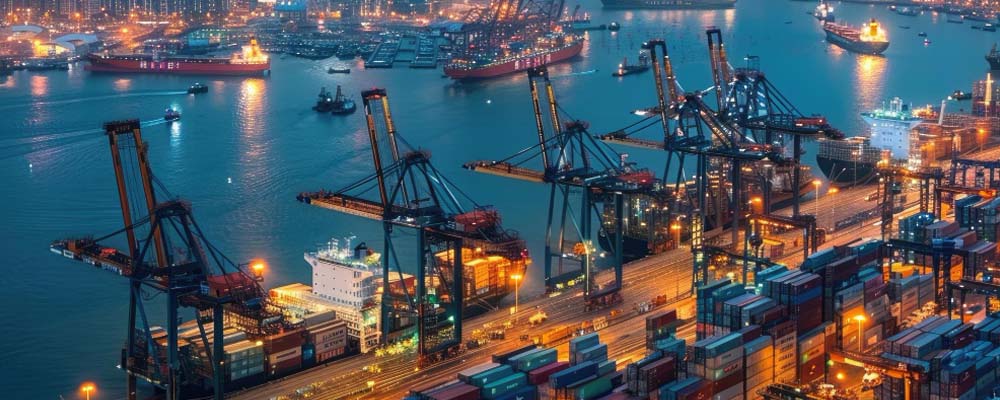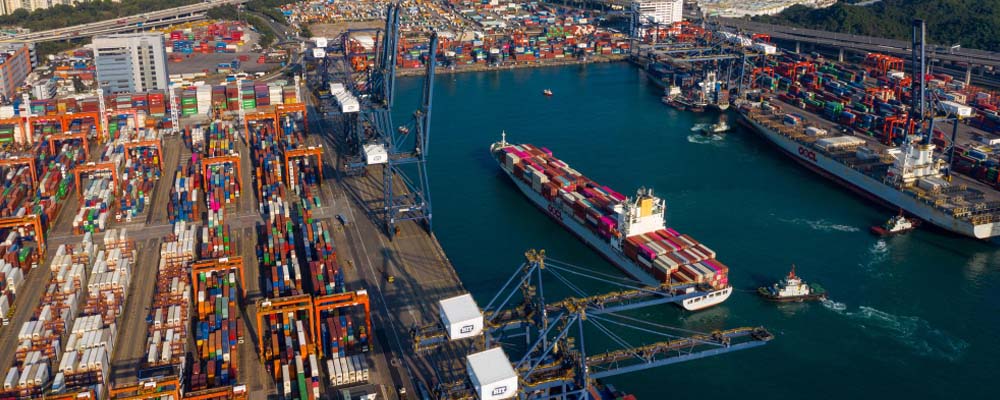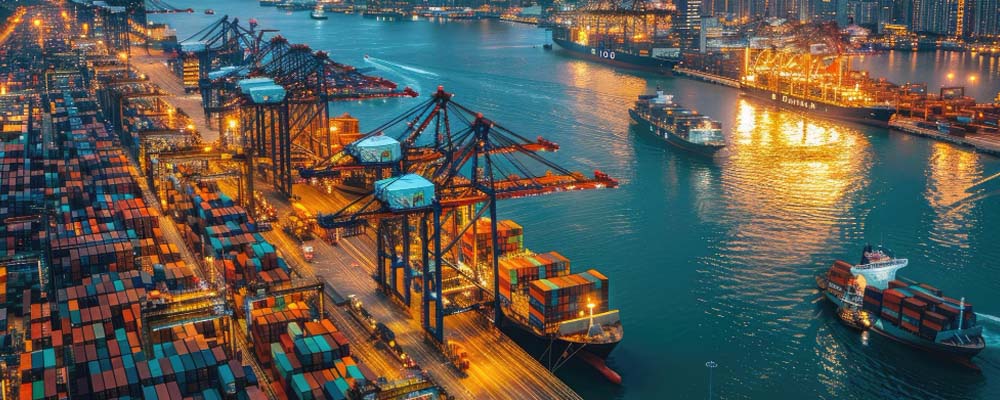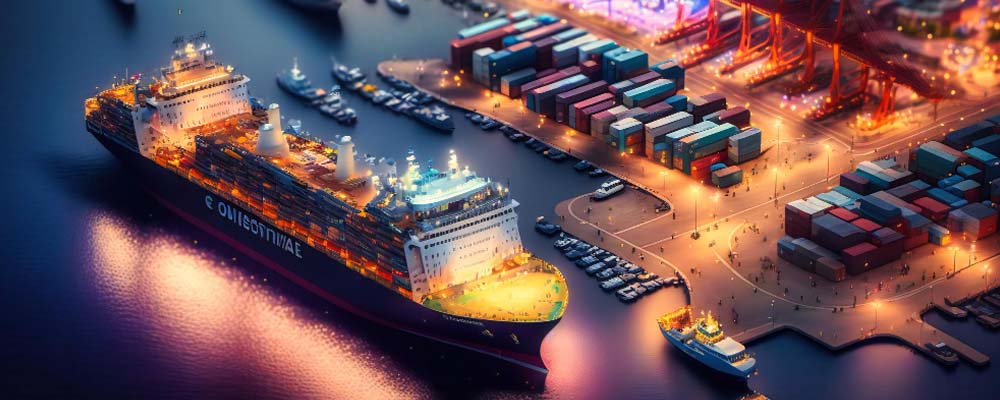
In the dynamic world of global trade, ports play a crucial role in the movement of goods across the globe. For freight forwarding companies, logistics providers, manufacturers, and other stakeholders, understanding the capabilities and significance of the world’s top ports is essential. This comprehensive guide provides an in-depth look at the top 15 ports in the world for 2024. From handling capacities to strategic locations, we’ll explore what makes these ports the linchpins of international trade.
Top 15 Ports in the World 2024
1. Port of Shanghai, China
TEUs handled: 47.03 million
The Port of Shanghai stands as the world’s busiest port, handling an astounding 47.03 million TEUs annually. This port is a pivotal hub in global trade, driving significant cargo volumes through its extensive facilities.
Shanghai’s strategic location on the Yangtze River Delta enhances its accessibility and efficiency. It connects with over 500 ports in 214 countries, making it a vital point in international logistics.
Equipped with state-of-the-art container terminals and specialized cargo handling facilities, the Port of Shanghai sets the benchmark for efficiency and operational excellence in maritime trade.
2. Port of Singapore, Singapore
TEUs handled: 37.49 million
Ranking second globally, the Port of Singapore handles 37.49 million TEUs. It is renowned for its unparalleled efficiency and strategic location, making it a key transshipment hub in Southeast Asia.
Singapore’s port connects to 600 ports in 123 countries, facilitating seamless global trade operations. Its cutting-edge technology and robust infrastructure streamline cargo handling processes.
The port significantly contributes to Singapore’s economy, supporting a wide range of industries from manufacturing to services, thereby bolstering the nation’s GDP.
3. Port of Ningbo-Zhoushan, China
TEUs handled: 31.07 million
Handling 31.07 million TEUs, the Port of Ningbo-Zhoushan links over 600 ports worldwide. It excels in managing raw materials and has extensive facilities to support its large-scale operations.
Specialized terminals for iron ore, coal, and crude oil make Ningbo-Zhoushan indispensable for raw material logistics. Its capability to manage bulk and containerized cargo simultaneously adds to its versatility.
Continuous investments in infrastructure and technological advancements ensure that Ningbo-Zhoushan remains a leading port in global trade.
 4. Port of Shenzhen, China
4. Port of Shenzhen, China
TEUs handled: 28.77 million
With an annual volume of 28.77 million TEUs, the Port of Shenzhen is pivotal for handling containerized cargo, bulk goods, and technological products. Its advantageous position significantly boosts its impact on international trade.
Shenzhen’s proximity to major technology manufacturing centers, including those in the Pearl River Delta, facilitates the swift movement of high-tech goods globally.
Advanced container terminals and efficient logistics operations make Shenzhen a model of modern port management.
5. Port of Guangzhou, China
TEUs handled: 24.18 million
Handling 24.18 million TEUs annually, the Port of Guangzhou plays a major role in trade along southern China’s coast, facilitating a wide range of industrial activities.
Guangzhou’s port is adept at managing various types of cargo, from general goods to specialized industrial materials, making it a versatile and critical component of China’s trade infrastructure.
The port’s activities significantly contribute to the economic development of Guangdong Province, supporting numerous industries and businesses.
6. Port of Qingdao, China
TEUs handled: 23.71 million
Managing 23.71 million TEUs, the Port of Qingdao is one of the busiest in the world. It features specialized facilities for iron ore and oil products, enhancing its cargo handling capabilities.
Qingdao’s strategic location on the Shandong Peninsula provides easy access to major shipping routes, facilitating efficient global trade operations.
Investments in expanding port infrastructure and adopting new technologies ensure sustainable growth and competitiveness.
7. Port of Busan, South Korea
TEUs handled: 22.71 million
South Korea’s main port, Busan, processes 22.71 million TEUs. It serves as a significant transshipment hub, connecting to numerous ports globally.
Busan employs advanced port management systems and automation to enhance efficiency and reduce turnaround times, making it a leader in port technology.
Strategically located, the port is a vital gateway for Korea’s import and export activities, particularly for electronic goods and automobiles.
 8. Port of Hong Kong, Hong Kong
8. Port of Hong Kong, Hong Kong
TEUs handled: 17.8 million
Handling 17.8 million TEUs annually, the Port of Hong Kong remains a crucial hub for manufactured goods and serves as a major gateway in East Asia.
Hong Kong’s port supports a diverse range of industries, from electronics to textiles, contributing significantly to the region’s GDP.
Its strategic location and robust infrastructure facilitate efficient connections with major global trade routes.
9. Port of Tianjin, China
TEUs handled: 20.27 million
Managing 20.27 million TEUs, the Port of Tianjin is China’s largest artificial port. Its strategic proximity to Beijing makes it a vital entry point for cargo.
Tianjin handles a wide array of cargo, from containers to bulk goods, supporting various industries in northern China.
The port’s activities bolster the economic development of the Beijing-Tianjin-Hebei region, fostering trade and industry growth.
10. Port of Rotterdam, Netherlands
TEUs handled: 15.3 million
Handling 15.3 million TEUs, the Port of Rotterdam is Europe’s largest port. It is a hub for petrochemicals and biofuels, playing a key role in global maritime trade.
Rotterdam’s strategic position at the mouth of the Rhine River enhances its connectivity to inland Europe, facilitating efficient cargo movement.
The port is investing in sustainable practices and green technologies, aiming to become a leader in environmentally-friendly shipping.
11. Port of Jebel Ali, UAE
TEUs handled: 14 million
Processing 14 million TEUs, the Port of Jebel Ali is the largest in the Middle East. It serves as a major logistics and trade center in the region.
Jebel Ali’s world-class logistics facilities and free trade zone attract businesses from around the world, supporting regional economic growth.
Its location near the Strait of Hormuz makes it a critical point for global trade, particularly for energy exports.
12. Port of Antwerp, Belgium
TEUs handled: 13.5 million
Handling 13.5 million TEUs, the Port of Antwerp is a significant European port with facilities to accommodate large vessels and extensive cargo handling capabilities.
Antwerp’s port supports various industries, including petrochemicals, automotive, and machinery, playing a vital role in Europe’s industrial landscape.
Advanced logistics and warehousing facilities ensure efficient cargo handling and distribution, enhancing the port’s competitive edge.
 13. Port of Hamburg, Germany
13. Port of Hamburg, Germany
TEUs handled: 8.4 million
With 8.4 million TEUs, the Port of Hamburg is Germany’s primary port. It serves as a critical gateway for international trade in Europe.
Hamburg’s strategic location on the Elbe River provides direct access to the North Sea, facilitating efficient maritime trade.
The port’s activities significantly contribute to the economic development of the Hamburg metropolitan region, supporting various industries and businesses.
14. Port Klang, Malaysia
TEUs handled: 14.06 million
Managing 14.06 million TEUs, Port Klang is a key player in Southeast Asian maritime trade, supporting a wide array of goods.
Located on the Strait of Malacca, Port Klang serves as a vital transit point for global trade routes, enhancing its strategic importance.
Port Klang’s comprehensive cargo handling services support various industries, from manufacturing to retail, fostering regional economic growth.
15. Port of Xiamen, China
TEUs handled: 12.43 million
Handling 12.43 million TEUs, the Port of Xiamen is an important port on China’s southeast coast, facilitating significant volumes of cargo.
Xiamen’s port infrastructure includes modern container terminals and efficient logistics facilities, ensuring smooth cargo operations.
The port’s activities contribute to the economic development of Fujian Province, supporting various industries and businesses.
 Conclusion
Conclusion
Understanding the capabilities and significance of the world’s top ports is crucial for stakeholders in international trade. These ports not only facilitate the efficient movement of goods but also drive economic growth and support various industries. By leveraging the strengths of these ports, businesses can enhance their logistics operations and gain a competitive edge in the global market.




 4. Port of Shenzhen, China
4. Port of Shenzhen, China 8. Port of Hong Kong, Hong Kong
8. Port of Hong Kong, Hong Kong 13. Port of Hamburg, Germany
13. Port of Hamburg, Germany Conclusion
Conclusion



